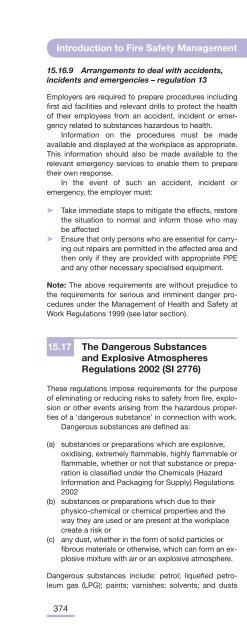Introduction to Fire Safety Management
Introduction to Fire Safety Management
Introduction to Fire Safety Management
Create successful ePaper yourself
Turn your PDF publications into a flip-book with our unique Google optimized e-Paper software.
<strong>Introduction</strong> <strong>to</strong> <strong>Fire</strong> <strong>Safety</strong> <strong>Management</strong><br />
15.16.9 Arrangements <strong>to</strong> deal with accidents,<br />
incidents and emergencies – regulation 13<br />
Employers are required <strong>to</strong> prepare procedures including<br />
fi rst aid facilities and relevant drills <strong>to</strong> protect the health<br />
of their employees from an accident, incident or emergency<br />
related <strong>to</strong> substances hazardous <strong>to</strong> health.<br />
Information on the procedures must be made<br />
available and displayed at the workplace as appropriate.<br />
This information should also be made available <strong>to</strong> the<br />
relevant emergency services <strong>to</strong> enable them <strong>to</strong> prepare<br />
their own response.<br />
In the event of such an accident, incident or<br />
emergency, the employer must:<br />
➤ Take immediate steps <strong>to</strong> mitigate the effects, res<strong>to</strong>re<br />
the situation <strong>to</strong> normal and inform those who may<br />
be affected<br />
➤ Ensure that only persons who are essential for carrying<br />
out repairs are permitted in the affected area and<br />
then only if they are provided with appropriate PPE<br />
and any other necessary specialised equipment.<br />
Note: The above requirements are without prejudice <strong>to</strong><br />
the requirements for serious and imminent danger procedures<br />
under the <strong>Management</strong> of Health and <strong>Safety</strong> at<br />
Work Regulations 1999 (see later section).<br />
15.17 The Dangerous Substances<br />
and Explosive Atmospheres<br />
Regulations 2002 (SI 2776)<br />
These regulations impose requirements for the purpose<br />
of eliminating or reducing risks <strong>to</strong> safety from fi re, explosion<br />
or other events arising from the hazardous properties<br />
of a ‘dangerous substance’ in connection with work.<br />
Dangerous substances are defi ned as:<br />
(a) substances or preparations which are explosive,<br />
oxidising, extremely fl ammable, highly fl ammable or<br />
fl ammable, whether or not that substance or preparation<br />
is classifi ed under the Chemicals (Hazard<br />
Information and Packaging for Supply) Regulations<br />
2002<br />
(b) substances or preparations which due <strong>to</strong> their<br />
physico-chemical or chemical properties and the<br />
way they are used or are present at the workplace<br />
create a risk or<br />
(c) any dust, whether in the form of solid particles or<br />
fi brous materials or otherwise, which can form an explosive<br />
mixture with air or an explosive atmosphere.<br />
Dangerous substances include: petrol; liquefi ed petroleum<br />
gas (LPG); paints; varnishes; solvents; and dusts<br />
374<br />
which when mixed with air could cause an explosive<br />
atmosphere, for example dusts from milling and sanding<br />
operations. Dangerous substances can be found, in<br />
varying quantities, in most workplaces.<br />
An explosive atmosphere is an accumulation of<br />
gas, mist, dust or vapour, mixed with air, which has<br />
the potential <strong>to</strong> catch fi re or explode. An explosive<br />
atmosphere does not always result in an explosion, but<br />
if it caught fi re the fl ames would quickly travel through<br />
it and if this happened in a confi ned space (e.g. in plant<br />
or equipment) the rapid spread of the fl ames or rise in<br />
pressure could also cause an explosion.<br />
15.17.1 Employers general duties – regulation 4<br />
The employer must:<br />
➤ Carry out a risk assessment of any work activities<br />
involving dangerous substances<br />
➤ Provide measures <strong>to</strong> eliminate or reduce risks as far<br />
as is reasonably practicable<br />
➤ Provide equipment and procedures <strong>to</strong> deal with<br />
accidents and emergencies<br />
➤ Provide information and training <strong>to</strong> employees<br />
➤ Classify places where explosive atmospheres<br />
may occur in<strong>to</strong> zones and mark the zones where<br />
necessary.<br />
15.17.2 Employers’ specifi c duties – regulation 5<br />
Employers are required <strong>to</strong> carry out suitable and suffi -<br />
cient assessment of the risks <strong>to</strong> their employees where a<br />
dangerous substance is or may be present at the workplace.<br />
This is also a requirement under the <strong>Management</strong><br />
of Health and <strong>Safety</strong> at Work Regulations (regulation 3):<br />
‘Risk’ is defi ned as meaning ‘the likelihood<br />
of a person’s safety being affected by harmful<br />
physical effects being caused <strong>to</strong> him from<br />
fi re, explosion or other events arising from<br />
the hazardous properties of a dangerous<br />
substance in connection with work and also<br />
the extent of that harm’.<br />
Employers are required by these regulations <strong>to</strong> eliminate<br />
or reduce risk so far as is reasonably practicable. Where<br />
risk is not eliminated, employers are required, so far as<br />
is reasonably practicable and consistent with the risk<br />
assessment, <strong>to</strong> apply measures <strong>to</strong> control risks and mitigate<br />
any detrimental effects (regulation 6(3)).<br />
The risk assessment shall include consideration as <strong>to</strong>:<br />
(a) the hazardous properties of the substance;<br />
(b) information on safety provided by the supplier,<br />
including information contained in any relevant<br />
safety data sheet;

















